If you’ve lived in Colorado for at least a year, you know how unpredictable the weather can be. With sudden snowstorms and fluctuating temperatures, having a reliable snowmelt system becomes more than just a convenience, it’s a necessity. As climate patterns shift and winters grow more intense, investing in a snowmelt system helps protect your property and improves safety for family, visitors, or customers.
Whether you're a homeowner or a business owner, a snowmelt system can prevent hazardous conditions on driveways, sidewalks, stairs, and even roofs. In this article, we’ll explain what a snowmelt system is, how it works, how to design one properly, and why you should trust professionals like Rogers and Sons Inc. for design and installation.
What is a Snowmelt System?
The biggest winter headache is trying to remove snow and ice from surfaces where people walk or drive. Traditional methods like shoveling or spreading salt are only temporary fixes. Worse yet, salt can damage concrete, plants, and vehicles, and trying to use it on roofs is nearly impossible. That’s where a snowmelt system comes in.
These systems offers a long-term, low-maintenance solution. It uses heating cables or tubing embedded under the surface of your driveway, sidewalk, patio, or roof. These cables warm up the surface to melt snow and ice on contact. The result is a consistently dry and safe area, even during heavy snowfall.
A properly installed system keeps water from refreezing, reducing the risk of dangerous ice buildup. These systems are built for outdoor conditions and are designed for energy efficiency and durability, delivering consistent performance season after season.
How to Design for Maximum Efficiency
Designing a snowmelt system isn’t a one-size-fits-all process. Every property is different, and that’s why we tailor each system to the specific needs of your home or business. Factors like square footage, average snowfall, and desired heating time all play a role.
When designing your system, we carefully calculate the following:
-
Snow melting load
-
Tube or cable spacing
-
Fluid supply temperature
-
Number of heating circuits
-
Flow rate and pressure drop
-
Proper pump capacity
A high-performance snowmelt system typically requires a heating capacity of around 100 BTU/hr per square foot. This allows it to handle snowfalls of up to 1.5 inches per hour. Most systems use a 50/50 mix of water and antifreeze, which can be adjusted based on local weather conditions.
As you can see, custom designed systems demand technical knowledge and precision. That’s why professional expertise is critical to achieving long-lasting results.
Installing a Snowmelt System the Right Way
Just like with the design phase, proper installation is crucial to the success of your snowmelt system. Each system includes three main parts: heating cables or tubing, a control unit, and an activation device. These components work together to ensure your system operates automatically and efficiently.
Control units are usually installed in weather-resistant wall panels and housed in NEMA-rated enclosures. They feature components like power terminals, relays, sensors, transformers, and monitoring electronics. Once installed, the system automatically activates when freezing temperatures are detected and turns off when conditions improve.
Whether you need to keep your business accessible or your family safe at home, a professionally installed snowmelt system provides peace of mind.
Why Choose Rogers and Sons?
At Rogers and Sons Inc., we take pride in helping Colorado homeowners and business owners design and install custom snowmelt systems that enhance safety, improve property value, and reduce winter maintenance.
With decades of HVAC and system integration experience, we understand what it takes to build an effective snowmelt system that’s both energy-efficient and built to last. From your initial consultation to the final installation, we ensure your system is designed around your needs and performs reliably through the harshest winters.



